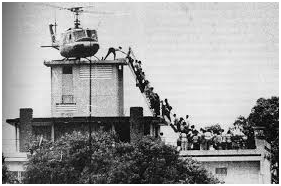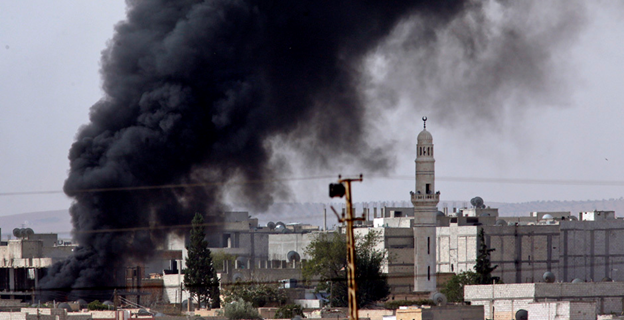Yesterday, we posted commentary on Jonathan Schanzer‘s, Politico Magazine piece, “Time to kick Turkey Out of NATO?” We noted what was behind Erdogan’s refusal to commit forces to lift the ISIS siege of the beleaguered Syrian Kurdish city of Kobani. We concluded:
Erdogan clearly wants the Syrian Kurds decimated so that they will not have virtual autonomy in the country’s northeast.
We note Schanzer’s conclusion in his Politico article:
The crisis in Kobani once again brings the challenge of Turkey into sharp relief. Despite the best efforts of Washington and other coalition members to bring Turkey along, it now appears clear: Turkey under the AKP is a lost cause. It is simply not a partner for NATO. Nor is it a partner in the fight against the Islamic State.
Marie Herf, one of the two Department of State spokespersons, held forth at yesterday’s Daily Press Briefing packed with US and foreign journalists. She spoke about the meetings in Ankara with US Coalition military chief Gen. James Allen and Amb. Brett McGurk to be followed by a Pentagon military planning team next week to discuss what assistance the Turkish NATO ‘ally’ might render in the fight against ISIS. The impression left, given questions by journalists at the Daily Press Briefing, is that Turkey will do nothing to aid the Syrian Kurds in Kobani, while the US conducts periodic air assaults that have yet to blunt the ISIS forces surrounding the city. Her colleague, Jen Psaki was engaged in a HuffPost cocktail hour discussion with Washington journalists about the dilemma of the stubborn, but apparently valiant Kurdish PYG defense of the shrinking perimeter inside Kobani against ISIS. The YPG is affiliated with the Kurdish Workers’ Party (PKK) that the Turks, EU and US have designated as terrorists. Turkish President Erdogan considers the PKK and hence the YPG to be ‘worse than ISIS’.
Violent protests by Kurds have erupted in the predominately Kurdish southeastern provinces of Turkey and in major cities. These have taken the lives of over 36 protesters. The Daily Beast reported:
For three nights now Kurdish protestors, riot police and Turkish ultranationalists have battled each other in dozens of towns across the southeast as well as in Istanbul and the capital Ankara. More than 30 have died so far in the violence and more than 1000 people have been arrested, according to Turkish Interior Minister Efkan Ala. And for the first time in years soldiers are on the streets of the Kurdish towns of Diyarbakır, Mardin, Van and Batman, where curfews have been imposed.
The lockdowns have not stopped the protests. Armed with Molotov cocktails, furious Kurds have been firebombing schools, government buildings and political party offices.
In Diyarbakır, a PKK stronghold, protestors defied orders to remain indoors. “Some people stay at home and just make noise in protest,” a resident reported via email. “But others are going out. The city is crazy. Helicopters are hovering overhead the whole time. There are no cars or taxis but there are tanks.” Then she added: “There is a beautiful moon and the smoke of tear gas.”
Turkish forces were caught by a Voice of America cameraman firing on Syrian Kurdish protesters from the border town of Qamishli. Watch here:
My European source on Turkey commented that Erdogan’s suppression of Kurds in Turkey reflects his fear about the growing importance of Kurdish irredentism. He pointed out in our conversation that Kurds now account for 25 percent of Turkey’s population and are likely to increase in influence during Erdogan’s term as President. Erdogan has reached out to PKK leader Abdullah Ocalan, imprisoned on an Island in the Sea of Marmara off Istanbul, requesting him to issue a letter to his followers to remain calm. That clearly didn’t resonate with angry Kurds in Turkey. Kurdish protests and even street battles with ISIS supporters have occurred in Europe. Rallies in protest of Turkey’s inaction on Kobani have occurred in Canada and in Washington.
ISIS is reported to control half of Kobani, despite the limited air assault by the US-led coalition. According to the Syrian Observatory for Human Rghts, the YPG was taking a toll on ISIS attackers in fierce urban street fighting. Kurdish resistance leaders inside Kobani were tweeting that they were running out of ammunition. The National Post reported this comment from a Turkish Kurdish member of the Ankara Parliament:
“Islamists open automatic fire while Kurds are careful to fire single shots,” Faysal Sariyildiz, a Kurdish lawmaker in Turkey’s parliament who’s been monitoring the battle, said in an interview. “They are careful with ammunition since they don’t have logistics supplies like Islamic State.”
The fear of possible genocide by ISIS jihadists against Kurds trapped in Kobani was expressed by UN Special Envoy to Syria, Staffan de Mistura, a veteran Swedish-Italian diplomat. Mistura according to the BBC “urged Turkey to allow volunteers to cross into Syria to defend Kobani, and warned that as many as 700 people, mainly elderly civilians, were still trapped in the town. He gave this chilling comment about a possible massacre in Kobani at a news conference, ‘You remember Srebrenica,’ Staffan de Mistura said, referring to the Bosnian town where Serb forces slaughtered 8,000 Muslim men and boys in July 1995. ‘We never forgot and we probably never forgave ourselves for that.’
Without ammunition the Kurds have their backs to wall, Kobani is doomed to fall. Would the Peshmerga in Iraq supply that? Are their stocks available from the US National Security stockpile in Haifa, Israel? Israel, we are told has sold off its stocks of captured Soviet era weapons and ammunition. Although it could manufacture such ammunition, it is unlikely to do so.
The USAF has probably has available far more effective Special Operations aircraft with which to conduct a aerial campaign to stave off the ISIS forces ringing Kobani. The USAF Special Operations Command at Hurlburt Air Field in North West Florida has squadrons of the heavily armed Lockheed C-130A Spectre gunships and the Pilatus U-28 intelligence aircraft. Both have been used to great effect in Afghanistan. Watch this video of a C-30 Spectre Gunship in action. Then we have a number of Fairchild-Republic A-10 Thunderbolt Warthog National Guard units that are very effective tank killers. Watch this video of an A-10 Warthog in action. The Spectres are capable of staying over the target area in support of fighting in urban areas with massive firepower . They can take out troops, vehicles like the armored Humvees and tanks stolen from the fleeing Iraq national forces. They are more effective than the F-18A Hornets, F-16s and the Eurofiighter Tornados and drones currently utilized by the US-led coalition. Clearly there is no evidence that this Administration plans to use those USAF Special Operations aircraft.

US Embassy Helicopter Rescue Fall of Saigon April 1975
Besides, we have an even more pressing problem, defense of a 300 man US Marine contingent at the Baghdad International Airport now within range of stolen US artillery captured by ISIS. ISIS has conquered virtually all of Anbar Province. Provincial leaders have said that only US combat troops can prevent a complete takeover by ISIS. That puts the ISIS blitzkrieg on Baghdad’s doorstep. Should the runways and control tower at Baghdad airport be shelled or mortared the only way that those Marines might be evacuated is by helicopters and not the Apache attack ones we have dispatched. But then ISIS also has MANPADS capable of shooting down both civilian and military aircrafts and those Apaches. Baghdad airport’s possible fall to ISIS forces raises the question of how the thousands of American contractors, diplomatic staff, and US military advisors will get out to safety from Baghdad’s Green Zone? That daunting prospect conjures up something eerily familiar to those of us who are Vietnam era vets. The fall of Saigon in April 1975 with images of American Huey helicopters plucking off clamoring US diplomats and Vietnamese from the roof of the US Embassy.
Kobani’s likely fall to ISIS in the face of Turkish inaction despite US limited air attacks will be a momentary disaster awaiting the debacle of what might occur at Baghdad International Airport.
Besides, we have an even more pressing problem, defense of a 300 man US Marine contingent at the Baghdad International Airport now within range of stolen US artillery captured by ISIS. Should the runways and control tower be shelled or mortared the only way that those Marines might be evacuated is by Apache helicopters we have dispatched. But then ISIS also has MANPADS capable of shooting down both civilian and military aircrafts and those Apaches. Baghdad airport’s possible fall to ISIS forces raises the question of how the thousands of American contractors, diplomatic staff, and US military advisors will get out to safety from Baghdad’s Green Zone? That daunting prospect conjures up something eerily familiar to those of us who are Vietnam era vets. The fall of Saigon in April 1975 with images of American Huey helicopters plucking off clamoring US diplomats and Vietnamese from the roof of the US Embassy.
Kobani’s likely fall to ISIS in the face of Turkish inaction despite US limited air attacks will be a momentary disaster awaiting the debacle of what might occur at Baghdad International Airport.
EDITORS NOTE: This column originally appeared in the New English Review. The featured photo is of smoke from a U.S. coalition air strike in Kobani as seen from Suruc, Turkey taken on 10-10-2014. Source: AP/Leftaris, Pitarakis.



